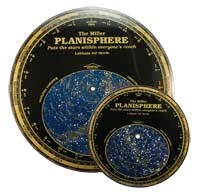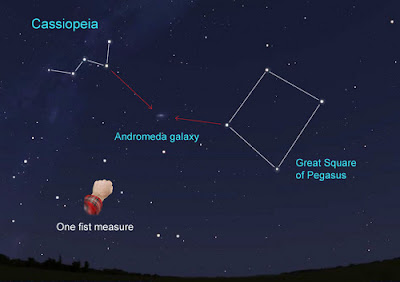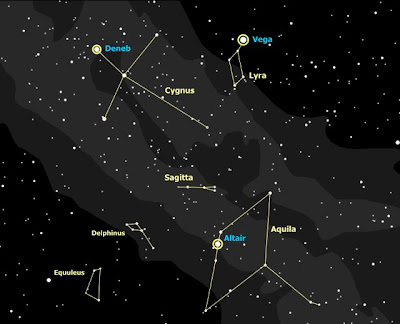 How it Works: The Night Sky Planisphere is made up of 2 sections -- an inner rotating dial marked with the days and months of the year, and a fixed outer section marked with the hours of the day. The dial contains a sky map printed with dark stars on a light background for easy nighttime readability.
How it Works: The Night Sky Planisphere is made up of 2 sections -- an inner rotating dial marked with the days and months of the year, and a fixed outer section marked with the hours of the day. The dial contains a sky map printed with dark stars on a light background for easy nighttime readability. Pick the date and hour you want to observe, and set the Star Wheel so this date (on the rim of the circular disk) matches the time indicated along the edge of the outer sleeve.
The Star Wheel's large oval shows the whole sky, and the oval's curved edge represents the horizon you're facing. If you're unsure of your directions, just remember where the Sun sets; that's west. Remember that star patterns will look much larger in the sky than they do on the map. The farther up from the edge of the oval the stars appear, the higher up they'll be shining in your sky. Stars in the center of the oval will appear directly overhead.
The longer you're outside, the better the chance that your eyes will adapt to the darkness and the more stars you'll be able to see. Planets aren't plotted on the Star Wheel, but they travel across the sky along an imaginary line called the ecliptic. It represents the path in the sky that brightest planets follow. If you see a bright "star" shining with a steady glow on or near this curved line, and the object isn't plotted on the Star Wheel, you're looking at a planet. The Moon travels very near the ecliptic in its orbit around Earth.
IMPORTANT: Planispheres are designed for specific latitude zones. When you buy a planisphere you must select one that is appropriate for your latitude. If you are not sure of your latitude look it up in a world atlas or click here to find it online for your town/city.
North Star LocationWhen you are facing the North Star you are looking toward true north. This is because by chance this lodestar lines up with the celestial sphere almost perfectly, so that all other stars appear to rotate around it. Simply by finding the North Star travelers are able to determine all the points of the compass: westward would be on your left, eastward to the right, and southward in back of you.
Many people erroneously think the North Star is one of the brightest stars in the sky and so is easy to find.
Finding the Big Dipper is Key to Finding the North Star The key to locating the North Star in the night sky is to first find the Big Dipper, a constellation of stars known as Ursa Major. The Big Dipper is perhaps the best known group of stars in the northern sky and is easy to distinguish from all others. Also known as the Great Bear, the Big Dipper is located just north of the celestial pole. Knowing how to find the Big Dipper makes it easy to find the north star.
The second key to finding the North Star is a similarly shaped constellation of stars known as the Little Dipper. The Little Dipper, also known as Ursa Minor, is smaller and more difficult to find in the night sky. Fortunately its big brother the Big Dipper points the way.
The PoleStar we are seeking is the brightest of the Little Dipper stars and is located at the tip of the dipper’s handle.
Finding other constellations using the Big Dipper
If you can find the big dipper in the sky, you have a starting point for identifying many other stars. Learn to use it as a skymark for the following constellations. Practice tracing from the Big Dipper by finding them on your planisphere--but remember that the shapes of constellations are distorted as you move toward the outer edge of the planisphere, and lines that appear straight in the real sky will not look straight on the flat surface of the planisphere.
 The Pointers: The two stars forming the pouring edge of the Big Dipper's bowl (on the side away from the handle) point to Polaris, the north star, in the constellation Ursa Minor, Little Bear. Polaris is a rather faint star about five times farther away than the distance between the pointers themselves.
The Pointers: The two stars forming the pouring edge of the Big Dipper's bowl (on the side away from the handle) point to Polaris, the north star, in the constellation Ursa Minor, Little Bear. Polaris is a rather faint star about five times farther away than the distance between the pointers themselves.- If you continue on this line from the Pointers on past Polaris, at an equal distance opposite the big dipper, you will intersect Cassiopeia. Cassiopeia, Queen of Ethiopia, is a W-shaped constellation reclining in the starry band of the Milky Way.
- Trace a line from the Pointers of the Big Dipper to
 Polaris and past Cassiopeia, and you will come to a large, nearly perfect square of four stars (almost directly overhead in autumn) called the Great Square of Pegasus (Pegasus was a flying horse). At one corner of the Square of Pegasus is Andromeda (daughter of Cassiopeia). The constellation Andromeda contains the Andromeda galaxy, also known as M31. The Andromeda galaxy is relatively close to the Milky Way, and is a bit larger than our own galaxy.
Polaris and past Cassiopeia, and you will come to a large, nearly perfect square of four stars (almost directly overhead in autumn) called the Great Square of Pegasus (Pegasus was a flying horse). At one corner of the Square of Pegasus is Andromeda (daughter of Cassiopeia). The constellation Andromeda contains the Andromeda galaxy, also known as M31. The Andromeda galaxy is relatively close to the Milky Way, and is a bit larger than our own galaxy. - "Arc to Arcturus." Follow the curve of the Big Dipper's handle away from the bowl to the fourth brightest star in the earth's sky, Arcturus, of the ancient constellation Boötes (pronounced "boo-oh-tees"). Boötes is a herdsman, or shepherd, and is found in cave paintings commemorating
 successful hunts of gazelles, zebras, and giraffes in the Sahara--this constellation was named before the Sahara became a desert. Arcturus is best seen in late summer.
successful hunts of gazelles, zebras, and giraffes in the Sahara--this constellation was named before the Sahara became a desert. Arcturus is best seen in late summer. - Continue past Arcturus on the same curve away from the Dipper's handle. After going the same distance again as it took to reach Arcturus, you will come (if it's not below the horizon) to a bright star of the constellation Virgo called Spica (spy-ka). "Speed on to Spica!" is a handy way to remember this. Alternatively, the phrase "Spike to Spica" refers to Spica's usual location near the horizon. Spica lies nearly on the ecliptic--the path the Sun follows across the sky. Spica may have an occasional bright visitor nearby--a planet wanderer, not a permanent resident!
- Return to the bowl of the Dipper. A line running through the two stars nearest the handle points almost directly to two other notable stars. Pointing down beneath the bottom of the Dipper bowl the line would take you to Regulus, the brightest star in the constellation Leo (a lion, whose mane looks like a backward question mark--Regulus is the "dot" at the bottom of the mark).

- In the other direction, pointing above the open bowl, the line runs to Deneb, in the constellation Cygnus (the Swan, which looks like a cross). Deneb is the tail of the swan, which is flying south for the winter along the Milky Way. Deneb, together with two other stars (Vega and Altair) form the summer triangle, an asterism which dominates the night sky all summer long.
- Look at the second star from the end of the Dipper's handle. Can you see anything unusual about it?
- Have binoculars? Test your eyesight by looking at the second star again. Look closely, and you may see two stars (Alcor and Mizar), which have been called the Horse and Rider. According to the Greeks, the second star is one of the Pleiades sisters, who left her six sisters over in Taurus when she married. Mizar, the brightest of the two, resolves into a double star (A & B) in a large telescope. Interestingly, from spectroscopic evidence it is known that Mizar A and Mizar B are each double stars as well, although these pairs are not resolvable by existing telescopes.

What is a Constellation?



